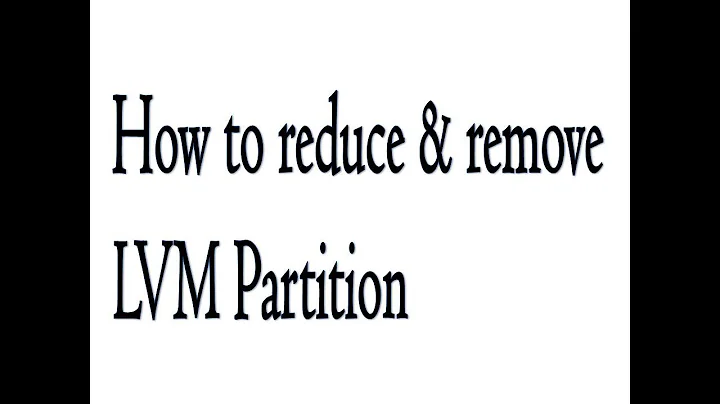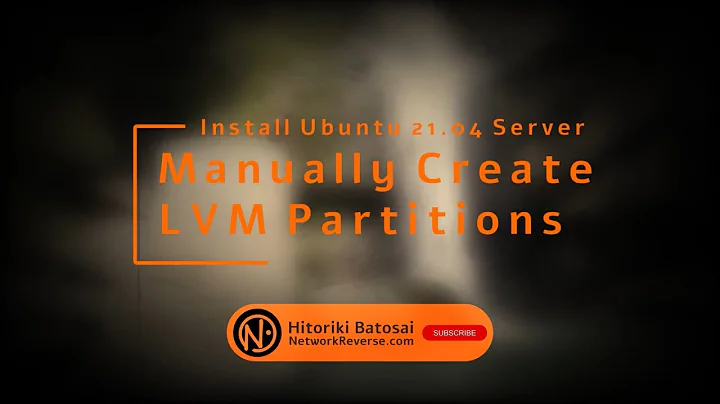How to mount sdb directly or using LVM partitions on sda?
Solution 1
I think that what you're asking for is to know if you need to create a logical volume in order to use the device /dev/sdb. If that's the question, no, you don't need to use LVM at all. You can directly create a file system on /dev/sdb and then mount it in your desired directory. Basically:
mkdir /mybackup
mkfs.ext4 /dev/sdb
echo "/dev/sdb /mybackup ext4 defaults 0 0" >> /etc/fstab
mount -a
If you want to use LVM anyway, you can create a new physical volume, then add it to the volume group present in your system (VolGroup), create a logical volume and then use it the same way explained above:
pvcreate /dev/sdb # Tags /dev/sdb as a physical volume
vgextend VolGroup /dev/sdb # Extends volume group VolGroup with the new PV
lvcreate -l 100%FREE VolGroup -n lv_mybackup # Creates a new LV from VolGroup
mkdir /mybackup
mkfs.ext4 /dev/VolGroup/lv_mybackup
echo "/dev/VolGroup/lv_mybackup /mybackup ext4 defaults 0 0" >> /etc/fstab"
mount -a
The first approach is the easy one, and the second one gives you the advantages of LVM.
Solution 2
If your question is "should I bother figuring out this LMV stuff? It is weird." The answer is yes! I am fairly new, but the one thing I really love about LVM is that it is much easier to make changes when you need more space. It is more complicated than that, so read up here (and other places):
What is LVM and what is it used for?
If you want to know if you should create a partition on the block device or not before doing the LVM steps, I can tell you that it works fine without, but... The 'greybeard' here at work noticed me doing that and started giving my crap about it. He said that it is the "preferred method" to create a partition on the block device first. So I can tell you that Daniel Sanchez's solution should work (and even looks elegant to me), but I think that the documented 'right way' is more like:
fdisk /dev/sdb
# make a new partition with all defaults
# change the partition type to '8e'
# save your changes and exit fdisk
pvcreate /dev/sdb1 # Tags /dev/sdb1 as a physical volume
vgextend VolGroup /dev/sdb1 # Extends volume group VolGroup with the new PV
lvcreate -l 100%FREE VolGroup -n lv_mybackup # Creates a new LV from VolGroup
mkdir /mybackup
mkfs.ext4 /dev/VolGroup/lv_mybackup
echo "/dev/VolGroup/lv_mybackup /mybackup ext4 defaults 0 0" >> /etc/fstab"
mount -a
You can read up on this stuff until your eyes bleed, but this page is a place to start:
Related videos on Youtube
Pit
Updated on September 18, 2022Comments
-
Pit over 1 year
I am new to LVM and VM yet, and I need to be able to access sdb like /mybackup/ 1 - should I have sdb1 created then mount? 2 - should I mount sdb as whole disk without LVM? 3 - create lvm and than mount?
what is the best way?
so far here what I have:
[root@localhost /]# lsblk NAME MAJ:MIN RM SIZE RO TYPE MOUNTPOINT sr0 11:0 1 1024M 0 rom sda 8:0 0 60G 0 disk ├─sda1 8:1 0 500M 0 part /boot └─sda2 8:2 0 59.5G 0 part ├─VolGroup-lv_root (dm-0) 253:0 0 48.8G 0 lvm / ├─VolGroup-lv_swap (dm-1) 253:1 0 6G 0 lvm [SWAP] └─VolGroup-lv_home (dm-2) 253:2 0 4.8G 0 lvm /home sdb 8:16 0 320G 0 disk [root@localhost /]# [root@localhost /]# pvscan PV /dev/sda2 VG VolGroup lvm2 [59.51 GiB / 0 free] Total: 1 [59.51 GiB] / in use: 1 [59.51 GiB] / in no VG: 0 [0 ] [root@localhost /]# pvscan PV /dev/sda2 VG VolGroup lvm2 [59.51 GiB / 0 free] Total: 1 [59.51 GiB] / in use: 1 [59.51 GiB] / in no VG: 0 [0 ] [root@localhost /]# lvscan ACTIVE '/dev/VolGroup/lv_root' [48.75 GiB] inherit ACTIVE '/dev/VolGroup/lv_home' [4.76 GiB] inherit ACTIVE '/dev/VolGroup/lv_swap' [6.00 GiB] inherit [root@localhost /]# fdisk -l Disk /dev/sda: 64.4 GB, 64424509440 bytes 255 heads, 63 sectors/track, 7832 cylinders Units = cylinders of 16065 * 512 = 8225280 bytes Sector size (logical/physical): 512 bytes / 512 bytes I/O size (minimum/optimal): 512 bytes / 512 bytes Disk identifier: 0x0000e17a Device Boot Start End Blocks Id System /dev/sda1 * 1 64 512000 83 Linux Partition 1 does not end on cylinder boundary. /dev/sda2 64 7833 62401536 8e Linux LVM Disk /dev/sdb: 343.6 GB, 343597383680 bytes 255 heads, 63 sectors/track, 41773 cylinders Units = cylinders of 16065 * 512 = 8225280 bytes Sector size (logical/physical): 512 bytes / 512 bytes I/O size (minimum/optimal): 512 bytes / 512 bytes Disk identifier: 0x00025293 Device Boot Start End Blocks Id System Disk /dev/mapper/VolGroup-lv_root: 52.3 GB, 52344913920 bytes 255 heads, 63 sectors/track, 6363 cylinders Units = cylinders of 16065 * 512 = 8225280 bytes Sector size (logical/physical): 512 bytes / 512 bytes I/O size (minimum/optimal): 512 bytes / 512 bytes Disk identifier: 0x00000000 Disk /dev/mapper/VolGroup-lv_swap: 6442 MB, 6442450944 bytes 255 heads, 63 sectors/track, 783 cylinders Units = cylinders of 16065 * 512 = 8225280 bytes Sector size (logical/physical): 512 bytes / 512 bytes I/O size (minimum/optimal): 512 bytes / 512 bytes Disk identifier: 0x00000000 Disk /dev/mapper/VolGroup-lv_home: 5108 MB, 5108662272 bytes 255 heads, 63 sectors/track, 621 cylinders Units = cylinders of 16065 * 512 = 8225280 bytes Sector size (logical/physical): 512 bytes / 512 bytes I/O size (minimum/optimal): 512 bytes / 512 bytes Disk identifier: 0x00000000 [root@localhost /]# cat /proc/partitions major minor #blocks name 8 0 62914560 sda 8 1 512000 sda1 8 2 62401536 sda2 8 16 335544320 sdb 253 0 51118080 dm-0 253 1 6291456 dm-1 253 2 4988928 dm-2 [root@localhost /]#
-
wurtel about 9 yearsIt's unclear what you're asking. Do you want to use /dev/sdb as an extra physical device for LVM, or do you just want to use it as a file system for backups?
-
-
telcoM about 6 yearsThe advantage of this procedure is that if the disk is accidentally presented to a Windows system, it will see the disk is in use and won't offer a single-click option to format it. The disadvantage is that if the capacity of the disk is increased (e.g. if it's a SAN LUN or a virtual disk of some virtualization platform), taking advantage of the increased capacity will be more complicated.
-
telcoM about 6 yearsAlso, if data alignment is an issue, you may need to make sure
fdiskis not using the ancient DOS-compatible scheme to set the start of partition at the start of a disk cylinder, and instead place the start of the partition to proper alignment, e.g. exactly 1Mbyte from the start of the disk (block #2048 if regular 512-byte disk blocks are used). For e.g. RHEL 6.x, you'll want to usefdisk -uc /dev/sdband then use the defaults. Different OS versions will need different options forfdiskfor proper alignment.







